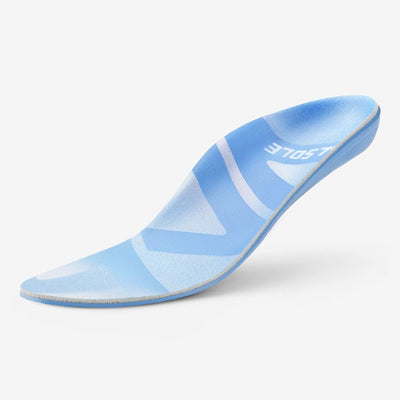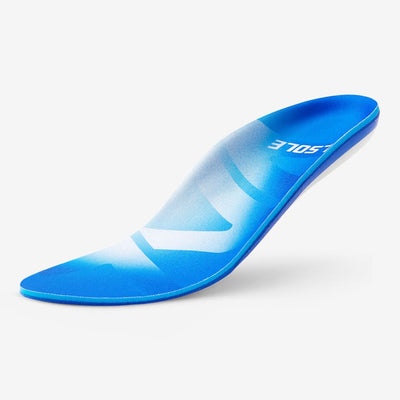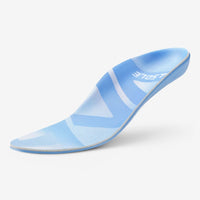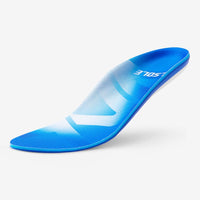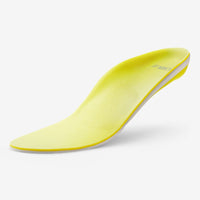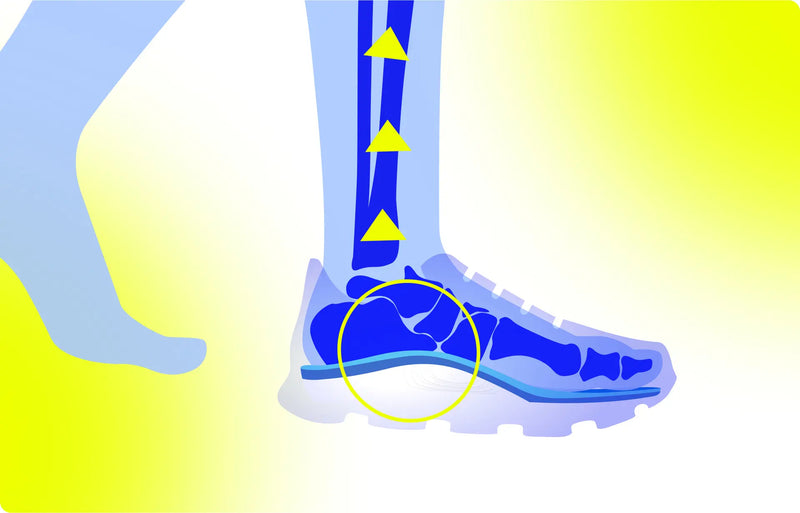The Impact of Foot Fatigue on Athletic Recovery

For athletes, the feet are the foundation of movement and performance, bearing repetitive stress during training and competition. As fatigue sets in, the structural integrity of the foot can be compromised, resulting in altered biomechanics, delayed recovery, and increased risk of injury. Understanding how foot fatigue influences recovery, and how supportive interventions like insoles can mitigate its effects, offers athletes a pathway to enhanced performance and reduced downtime in delayed and lengthened recovery processes.
The Physiology of Foot Fatigue
Foot fatigue results from repeated or prolonged mechanical loading of the foot structures, including muscles, tendons, ligaments, and fascia. Overuse without adequate rest can lead to muscle soreness, inflammation, and microtrauma, ultimately impairing the foot's ability to absorb shock and maintain proper alignment during movement. Prolonged foot fatigue may also hinder venous return and reduce circulation, delaying the removal of metabolic waste and slowing the delivery of oxygen and nutrients essential for muscle repair (Yoda et al., 2024).
The complexity of the foot's anatomy—comprising 26 bones, 33 joints, and over 100 muscles, tendons, and ligaments—means that even minor fatigue can have widespread consequences. With the plantar fascia, intrinsic foot muscles, and the Achilles tendon working in synergy to stabilize and mobilize the body, any impairment due to fatigue disrupts the entire kinetic chain. This makes the recovery process more demanding and emphasizes the need for preemptive and supportive strategies.
How Foot Fatigue Disrupts Recovery
Fatigued feet fail to provide the necessary support and shock absorption, which leads to compensatory movements and postural misalignment. This biomechanical shift stresses the knees, hips, and lower back, contributing to secondary injuries and prolonged recovery times. According to a medical study on foot and ankle awareness in athletes (Anderson, 2022), misfitted or unsupportive footwear is a common contributor to such issues, especially in high-impact sports where cleat-surface interaction and improper shoe fit exacerbate fatigue and injury rates.
Moreover, athletes experiencing foot fatigue may exhibit poor proprioception and diminished balance, which not only increases the risk of acute injuries but also impairs the body's natural recovery processes. When alignment is off and load distribution is uneven, healing tissues are subjected to excessive strain, potentially leading to chronic issues or re-injury.
The Role of Insoles in Reducing Foot Fatigue
Insoles play a pivotal role in addressing the underlying causes of foot fatigue. High-quality insoles offer:
-
Shock Absorption: Reducing the impact on joints and soft tissues by cushioning each step, particularly in high-impact zones like the heel and forefoot.
-
Arch Support: Helping maintain neutral alignment by supporting the natural curvature of the foot, reducing muscle fatigue, and preventing collapse of the arch.
-
Improved Weight Distribution: Ensuring pressure is evenly spread across the foot, minimizing localized strain and promoting biomechanical efficiency.
-
Enhanced Proprioception: Some insoles stimulate nerve endings in the feet, improving balance and coordination during recovery.
These functions collectively enhance post-exercise recovery by minimizing additional stress on fatigued tissues and facilitating a faster return to training.
In addition to their immediate biomechanical benefits, insoles can be a valuable preventive tool. Athletes who integrate insoles into their daily footwear often report reduced incidences of plantar fasciitis, Achilles tendonitis, and metatarsalgia. Insoles designed for athletic performance typically use multi-density foam or gel layers that provide graduated support, helping adapt to different movement patterns without sacrificing comfort or mobility.
Foot Support and Injury Recovery
For athletes recovering from lower extremity injuries, foot support is paramount. Proper insoles can accelerate healing by stabilizing the foot and ankle, promoting proper alignment, and offloading stress from injured tissues. For instance, conditions such as plantar fasciitis, Achilles tendinopathy, and stress fractures benefit significantly from the right foot support (Anderson, 2022).
Supportive insoles also correct compensatory gait patterns that often develop post-injury. By guiding the foot through a more natural movement path, insoles reduce the risk of secondary injuries and promote symmetrical muscle activation, which is essential during rehabilitation.
Furthermore, foot support helps maintain neuromuscular coordination during periods of reduced activity. Following an injury, athletes may experience deconditioning or proprioceptive deficits. Insoles with integrated arch and heel cupping features help provide sensory feedback to improve foot placement and motor learning. This is particularly important in sports involving rapid changes in direction, such as basketball, soccer, or tennis, where even a slight imbalance can compromise performance or trigger reinjury.
Evidence-Based Recovery Strategies
A systematic review by Yoda et al. (2024) emphasized the importance of combining biomechanical interventions, like insoles, with recovery modalities such as hydrotherapy, compression garments, and nutritional strategies. These integrative approaches were shown to reduce fatigue and expedite recovery in athletes across various sports.
Moreover, foot-specific recovery strategies can be integrated into daily routines. These include:
-
Foot Massage and Myofascial Release: To alleviate tightness and enhance blood flow.
-
Toe and Arch Exercises: Strengthening intrinsic foot muscles to maintain structural integrity.
-
Cold Water Immersion: As supported by studies cited by Yoda et al., it helps reduce inflammation and muscle soreness in the feet.
-
Progressive Load Training: Gradual reintroduction of load-bearing activities post-injury ensures the foot adapts without triggering excessive fatigue.
One promising area of research involves using wearable sensors embedded in insoles to monitor gait, pressure distribution, and fatigue markers in real-time. These tools can offer valuable feedback for trainers and physical therapists to customize recovery programs and optimize footwear decisions. As technology continues to evolve, personalized foot health tracking may become a cornerstone of athletic recovery.
Choosing the Best Insoles for You
Selecting appropriate insoles involves evaluating individual biomechanics and sport-specific demands. Key considerations include:
-
Foot Arch Type: Flat, neutral, or high arches require different support structures.
-
Activity Level and Sport: Runners may need more forefoot cushioning, while athletes in cutting sports might benefit from medial stability.
-
Material and Durability: EVA foam, gel, or composite materials offer varying degrees of cushioning and longevity.
-
Fit and Replaceability: Insoles should align properly with the shoe's last and be replaced regularly to maintain effectiveness.
Athletes should seek professional assessments, such as gait analysis or podiatric consultation, to ensure a customized fit. Custom orthotics may be necessary for those with significant alignment issues or injury history.
The Psychological Benefits of Reduced Foot Fatigue
While the physical benefits of proper foot support are well-documented, the psychological implications are just beginning to be explored. Chronic foot discomfort or injury can contribute to emotional fatigue, reduced motivation, and performance anxiety. Conversely, addressing foot fatigue can improve an athlete’s confidence and mental clarity. Knowing that one’s foundation is stable enables athletes to focus more on technique and execution rather than compensating for pain or instability.
The mind-body connection plays a critical role in recovery. According to a study from the British Journal of Sports Medicine (Koltyn, 1998), research has shown that pain perception, mood, and muscle activation are closely linked. Athletes who experience consistent comfort during training often recover faster, maintain better form, and demonstrate greater resilience during competition.
Foot fatigue is more than just an inconvenience—it is a biomechanical disruptor that can significantly impede recovery and performance. By addressing foot fatigue through evidence-based interventions like supportive insoles, athletes can enhance their post-exercise recovery, reduce injury risk, and improve long-term outcomes. High-quality insoles not only aid in reducing mechanical strain but also play a critical role in aligning the body and supporting tissue repair. As awareness grows, integrating foot health into holistic recovery programs will be key to maximizing athletic performance and longevity (Anderson, 2022).
When integrated into a broader strategy that includes active rest, targeted rehabilitation, and proper nutrition, foot support can serve as a cornerstone of sustainable athletic development. With continued research and innovation, the future of recovery may well begin at the feet.
References
1. Anderson, R. B. (2022). Foot and ankle awareness in the athlete. Sports Health, 14(3), 309-310. https://doi.org/10.1177/19417381221089976
2. Koltyn, K. F., & Arbogast, R. W. (1998). Perception of pain after resistance exercise. British Journal of Sports Medicine, 32(1), 20–24. https://doi.org/10.1136/bjsm.32.1.20
3. Yoda, I. K., Tisna MS, G. D., Suwiwa, I. G., Kusuma, K. C. A., & Junior, N. K. M. (2024). Recovery methods to reduce fatigue among athletes: A systematic review and future directions. Journal Sport Area, 9(2), 217-234. https://doi.org/10.25299/sportarea.2023.vol9(2).14781

